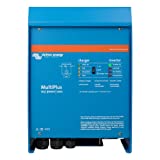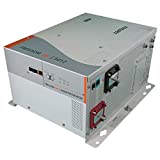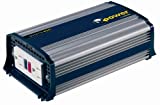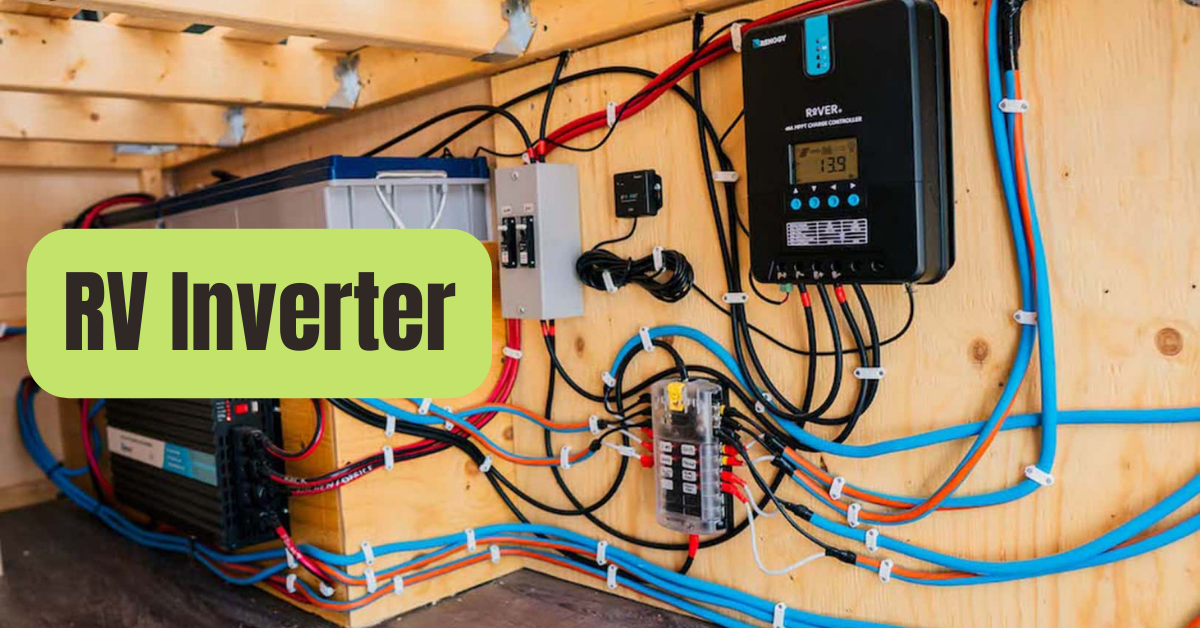You obviously appreciate off-grid camping and RV trips…
nonetheless, you also like the latest electrical comforts.
You use a computer for work.
You like brewing coffee in the morning and warming food in the microwave for supper.
Or maybe you plan to binge watch a few episodes of Queen’s Gambit since it is pouring outside.
If your adolescents don’t have access to their Xbox, they will ruin your relaxing nights.
Here comes your friend, the RV inverter.
An Rv Inverter Is What?
Numerous electronics and appliances need 120V AC electricity.
When you hook your RV into shore power, you’re bringing a supply of 120V AC energy inside your RV to power those gadgets, just as you would if you were at home.
However, your RV’s battery or batteries supply 12V DC electricity.
You thus need an inverter to convert the 12V DC energy from your RV’s batteries to 120V AC electricity so that you may use it with your 120V appliances when the source of your RV’s power is a battery bank, as it is while you are boondocking.
You’ll need to use your generator to power such gadgets if not.
Don’t get us wrong; this is just acceptable and what many RV owners choose to do.
Especially if you just sometimes use 120V AC power.
However, an RV inverter is your only choice if you want AC power more often (for instance, if you work from the road) and/or you prefer not to hear the drone of a generator for extended periods of time.
How Do RV Inverters Operate?
While AC (alternating current) fluctuates from +120V to -120V and back, DC (direct current) remains constant.
By first boosting the voltage and then changing it such that it alternates, a power inverter may transform 12V direct current into 120V alternating current.
To put it another way, an inverter converts your 12V DC power source to a 120V AC power supply.

Inverters with larger price tags also include bypass circuitry.
By doing this, they enter “Standby Mode” and cease drawing power from your batteries while you are using shore power, letting the shore power to travel straight to the circuits.
Some inverters that are even more advanced have a feature known as “Hybrid” or “Power Assist” capabilities.
These inverters momentarily draw power from the batteries and convert it to 120V electricity that is in perfect phase with the incoming power supply in order to supplement the supply of shore power (or a generator) in the event that the load or demand exceeds the supply.

Victron Multiplus 12/3000/120-50 120V VE.Bus
- Multi+ Inv/Chgr, 12V 3000VA 120A
On some types, the inverter may completely take over the loads on the circuits it powers, reducing the amount of electricity needed from your generator or the shore connection.
Our Xantrex Freedom SW inverter operates in this manner (they refer to it as “Generator Support Mode,” although it is compatible with both the generator and shore power).
It has the ability to detect the load being drawn by the equipment it is powering, and when that draw rises over a user-selectable threshold, it may switch to “invert” mode, eliminating those loads from the draw on the shore/generator.
Sale

Xantrex Freedom SW3012 12V 3000W Inverter/Charger [815-3012]
- One Xantrex Freedom SW Series 815-3012 Inverter & Charger and one battery temperature sensor are included with your order.
- Dimensions of the inverter are 7.75″ H x 13.5″ W x 15.25″ L; the product weighs 73.7 lbs; and there is no load. Inverting power draw: 3 adc | Output wave shape
Regardless of how your inverter functions, whether it is a “Hybrid” or “Generator Support” model, this feature can help prevent the pedestal breaker from tripping when you run the microwave to reheat your lunch while forgetting that you have the air conditioner and electric water heater running while on a 30-amp hookup.
You may blissfully savor your now-hot supper by either enhancing the available power (hybrid) or assuming control of part of the RVs circuits (generator support).
RV Inverter VS. RV Converter: What’s the Difference?
Many individuals are unable to distinguish between an INverter and a CONverter.
They are polar opposites of one another, which is the simplest explanation.
Each one of them alters the characteristics of the energy that flows through them, but in completely different ways.
- RV Inverter: Converts 12V DC electricity to 120V AC power, enabling you to utilize your RV’s batteries to power 120V items such as a microwave oven, television, or a laptop computer charging brick.
- RV Converter: does the opposite…For the purpose of powering onboard components like lights, fans, slide motors, and your water pump, it converts 120V AC power to 12V DC power.
Modern converters sometimes double as battery chargers, adding to the confusion (thus the phrase “converter/charger”).
This means that they can both replenish the power in your RV’s batteries (recharge them) using an appropriate charging cycle created for the type/chemistry of your battery and provide 12V DC power to the onboard systems of your RV (often being able to do this whether there is a battery in the system or not) (ies).
Even an inverter/charger combo (like ours) that does both tasks in one unit may be included with an RV.
This design has advantages and disadvantages.
The capacity of one box to do two tasks reduces the amount of equipment that must be installed and maintained, yet a single unit increases the possibility of a single point of failure.
Therefore, if your inverter/charger combo breaks down, you might lose both the inverter and the charger/converter at once.
Modified Versus Pure Sine Waves
RV inverters come in two varieties: pure sine wave and modified sine wave.
Cost and efficiency are the primary distinctions between them.
The electricity produced by a pure sine wave inverter is the same as the 120V AC power that emanates from your home’s outlets, and all 120V appliances and gadgets are designed to run on this kind of power.
They cost more but are more effective than modified sine wave inverters (though the price difference has been steadily decreasing over time).
The electricity generated by a modified sine wave inverter is less “pure” since it doesn’t give an exact reproduction of AC power, which might sometimes cause interference or even the failure of your gadgets.
Modified sine wave inverters are thus less costly, but they may be tougher on electronics, which might eventually harm the equipment they are powering.

When powered by modified sine wave, heated blankets and mattress pad controls, for instance, seem to be especially prone to malfunction.
A modified sine wave inverter may also cause power supplies, sometimes known as “wall warts,” to buzz and become warm or even heated.
Don’t worry if your RV has a modified sine wave inverter.
It will function as planned and provide 120V to the gadgets you need to power with it.
But if it ever breaks down, you may want to think about switching to a pure sine model.
How to Use an Inverter in an RV
No matter what kind of inverter you have, it’s unlikely to power everything inside the RV.
You’ll probably have one of a few different sorts.
The way your gear was wired by the manufacturer determines what it powers.
The inverter is often a portable device that plugs into the cigarette lighter and isn’t at all integrated into the RV in the simplest case.
These devices generally include one or two 120V AC plugs with modest power (200–400 Watts), allowing you to directly plug items in.
They’re a fantastic alternative for any RV that wasn’t built with an inverter and/or for those who simply need to power a few modest electronics (like charging a laptop).

Xantrex 851-0451 Xpower 450 Micro Inverter
- Up to 450 watts of AC items may be powered on the go.
- GFCI outlets for connecting two different loads
You just put a portable inverter into a 12V socket, switch it on, and then plug in whatever item you need to power with 120V AC.
However, bear in mind that since portable inverters often have a reduced capacity, you cannot use them to operate heavy appliances.
If an inverter was added when your RV was built, it is already wired directly to the 12V battery bank and should have a control panel inside the RV where you can switch it on and off.
It might modify what that RV inverter powers.
Sometimes the inverter that came with your RV is smaller and more comparable in size to a portable type (300-750 Watts).
If so, it may be configured such that it just powers one outlet, which might be used to power a CPAP machine, a laptop computer, or only the TV and DVD player.
In other circumstances, your RV’s inverter might be connected to a special circuit breaker box (like ours is), which controls only certain circuits, including those for the TV, microwave, and all (or some) of the outlets, but NOT those for high-power-draw appliances, like the air conditioner(s), washer/dryer, or the electric side of your RV refrigerator or water heater.
Rarely, most often due to an aftermarket installation, your RV inverter may be equipped to provide 120V AC power to the whole vehicle.
In this situation, you would need to take extra care to avoid overloading the inverter by using too many appliances at once.
Pay special attention to higher-draw appliances, especially air conditioners and heat-generating equipment like a 120V water heater or the 120V heating element of an RV refrigerator.
Additionally, you must be aware of the battery bank’s capacity to avoid using a gadget that uses up too many batteries too rapidly.
Should I Always Leave My Rv Inverter On?
An RV inverter doesn’t often need to be left on all the time.
Even without anything hooked into it, the inverter uses some electricity on its own, so you shouldn’t often keep it on when it’s not required to provide power.
However, YES – you probably want to keep your inverter on constantly if your RV has a home refrigerator.
In some high-end RVs, the refrigerator has its own, smaller inverter, but when there is just one aboard, a home refrigerator usually necessitates constant use of the RV inverter.
That is certainly true while boondocking since without the inverter turned on, the refrigerator wouldn’t get any power from the grid.
We do, however, keep our inverter on even while we are plugged into shore power since many years ago, we converted from an RV fridge to a home refrigerator.
Since there is a fully charged lithium battery bank and inverter that could have easily taken up the slack if only it were switched on and waiting, it would be a terrible tragedy if the fridge failed due to a power outage.

Which Inverter Size Is Required for My RV?
There isn’t a universal solution to it, thus you must first respond to the following queries:
1. What appliances and gadgets do you wish to run?
Take into account the appliances and electrical equipment you need to use, as well as those that may need to operate simultaneously (if any).
Generally speaking, planning or timing your energy use (brew your coffee all the way through before setting the toast down, for example) may assist to lower the maximum power an inverter will need to provide.
2. What size battery bank do you have?
Think about how big your battery bank is.
When you just have one battery or a tiny battery bank for your home, you can’t operate high-power-draw gadgets for very long.
As a result, you may be able to operate your TV for a few hours, but your microwave or hair dryer won’t be able to run for very long.
Your inverter requirements may be reduced if your battery bank is smaller.
3. Your maximum power drain, please?
You must be careful to account for start-up surges, which are typically three to five times the appliance’s operating power, in your calculations since certain appliances, equipment, and tools have significant surges.
The majority of inverters are equipped to handle brief surge demands.
Make sure you understand the power and duration that the inverter will truly give by carefully reading the ratings.
The maximum surge rating of an inverter is sometimes stated together with the inverter size (often given in Watts), although the smaller print may also state that the inverter can only tolerate a lesser wattage drain for prolonged durations.
Add the wattage needs of all the devices and appliances you want the inverter to power, as well as the surge requirements of all the devices that will be operating simultaneously, to determine the size of inverter you need.
Once you have that amount, increase it by an extra 20% to account for any further system losses or loads.

Do RV Inverters Pay Off?
While boondocking in the midst of the desert, on the beach, or in the forest, RV inverters are great for providing you with all the luxuries of home.
Additionally, it operates in silently.
Larger battery banks and a solar array that continuously supplies those batteries with the amazing power of the sun work especially well with RV inverters.
Once again, not everyone needs an RV inverter.
While some people choose to camp with full hookups and seldom use 120V electricity, others prefer to constantly rely on shore power to meet their energy demands.
We use quite a bit of electricity since we work and live full-time in our RV.
We also choose to live off the grid since we are true boondockers, thus we wouldn’t be without ours.
Conclusion
After learning what an RV inverter is, what it does, and how it operates, you can quickly determine whether or not an inverter is necessary for your family’s RV lifestyle by considering how you prefer to travel and camp.










